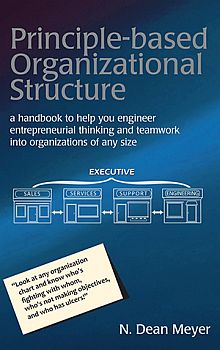| Excerpt from www.NDMA.COM, © 2025 N. Dean Meyer and Associates Inc.
Book:
Principle-based Organizational Structure
Table of Contents
FOREWORD: A CEO Who Has Applied the Principles of Structure
PART 1: Why You Should Read this Book
1: The Importance of Structure 2: The Science of Structure
PART 2: Fundamental Principles
3: Principle 1: Golden Rule: Authority and Accountability Must Match 4: Principle 2: Specialization and Teamwork 5: Principle 3: Precise Domains 6: Principle 4: Basis for Substructure 7: Principle 5: Avoid Conflicts of Interests 8: Principle 6: Cluster by Professional Synergies 9: Principle 7: Business Within a Business
PART 3: The Building Blocks of Organization Charts
10: Overview of the Building Blocks 11: Distinguishing Engineers and Service Providers 12: Engineers 13: Service Providers 14: Coordinators 15: Sales and Marketing 16: Audit
PART 4: Applying the Principles, Seeing the Problems
17: Diagnosing an Organization Chart: The Rainbow Analysis
PART 5: Structures Designed to Fail
18: Strategy as a Basis for Structure 19: Pick a Core Competency, Outsource the Rest 20: Managers as Client Liaisons 21: Decentralization 22: Dotted Lines and Matrix Structures 23: Plan-Build-Run 24: New Versus Old 25: Quick Versus Slow (Bi-modal) 26: The Pool 27: Boundaryless/Network/Cellular/Organic Organization 28: Leaderless Organization (Sociocracy and Holacracy)
PART 6: Design: How to Assemble the Building Blocks into an Organization Chart
29: Clean Sheet Versus Tweaks 30: Assumptions 31: All the Lines of Business 32: Clustering the Lines of Business 33: From Clusters to Boxes
PART 7: Special Situations and Design Guidelines
34: Self-managed Groups 35: Shared People: Temporary Duty 36: Remote Locations 37: Project Management Office 38: Compliance and Governance
PART 8: Workflows: You Can't Specialize If You Can't Team
39: What Not to Do to Improve Teamwork 40: High-performance Teamwork 41: The Limits of Traditional Approaches to Teamwork 42: The Teamwork Meta-process: Concepts
43: The Teamwork Meta-process:
PART 9: The Process of Restructuring
44: Change Management 45: The Restructuring Process, Step by Step 46: Establishing the Sales Function in an Internal Service Provider 47: Consolidation of Shared Services and Acquisition Integration
PART 10: Leadership Questions
48: Should I Do This? Benefits That Justify the Costs 49: When? Place Within a Transformation Strategy 50: What Should I Do Next? Ideas to Action APPENDIXES Appendix 1: Terminology Appendix 2: Supervisory Duties Appendix 3: Theoretical Underpinnings ENDNOTES (References) INDEX
|


